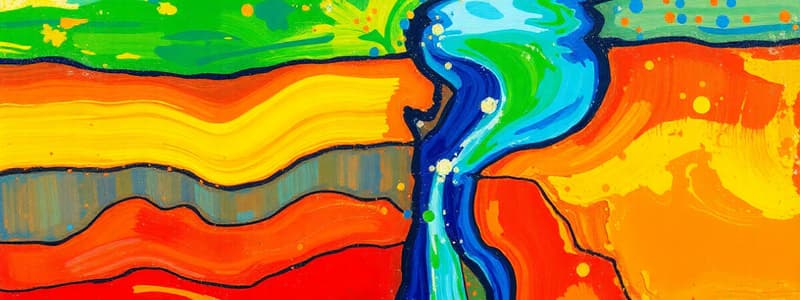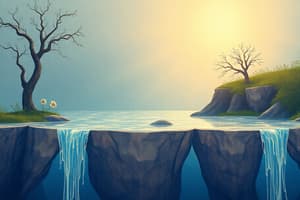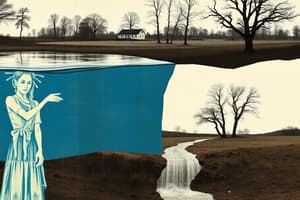Podcast
Questions and Answers
What is an aquifer?
What is an aquifer?
A permeable layer of rock and sediment that contains Groundwater.
Which of these options are correct? (Select all that apply)
Which of these options are correct? (Select all that apply)
- Unconfined aquifers are rapidly recharged by water that percolates downward from the land surface. (correct)
- Confined aquifers are capped by an impermeable layer of rock or clay, which can cause water pressure to build up underground. (correct)
- Aquifers are a source of usable groundwater. (correct)
- Artesian wells are formed when a well is drilled into a confined aquifer and the natural pressure causes water to rise toward the ground surface. (correct)
What is the uppermost level at which the water in a given area fully saturates rock or soil?
What is the uppermost level at which the water in a given area fully saturates rock or soil?
Water table
Groundwater recharge is the process by which water percolates through the soil and works its way into an aquifer.
Groundwater recharge is the process by which water percolates through the soil and works its way into an aquifer.
What is a natural source of water formed when water from an aquifer percolates up to the ground surface?
What is a natural source of water formed when water from an aquifer percolates up to the ground surface?
What is a well created by drilling a hole into a confined aquifer?
What is a well created by drilling a hole into a confined aquifer?
What is the name of the aquifer, also called the High Plains aquifer, that is the largest aquifer in the United States?
What is the name of the aquifer, also called the High Plains aquifer, that is the largest aquifer in the United States?
What is an area lacking groundwater due to rapid withdrawal by a well?
What is an area lacking groundwater due to rapid withdrawal by a well?
What is an infiltration of saltwater in an area where groundwater pressure has been reduces from extensive drilling of wells?
What is an infiltration of saltwater in an area where groundwater pressure has been reduces from extensive drilling of wells?
What is water that exists aboveground that includes streams, rivers, ponds, and wetlands?
What is water that exists aboveground that includes streams, rivers, ponds, and wetlands?
What is the land adjacent to a river?
What is the land adjacent to a river?
What is an enlarged bank built up on each side of a river?
What is an enlarged bank built up on each side of a river?
What is a structure built to prevent ocean waters from flooding adjacent land?
What is a structure built to prevent ocean waters from flooding adjacent land?
What is a barrier that runs across a river or stream to control the flow of water?
What is a barrier that runs across a river or stream to control the flow of water?
What is the water body created by a damming a river or stream?
What is the water body created by a damming a river or stream?
What is a stair-like structure that allows migrating fish to get around a dam?
What is a stair-like structure that allows migrating fish to get around a dam?
What is a canal, ditch, or pipe used to carry water from one location to another?
What is a canal, ditch, or pipe used to carry water from one location to another?
What is the process of removing the salt from saltwater?
What is the process of removing the salt from saltwater?
What is a process of desalination in which water is boiled and the resulting steam is captured and condensed to yield pure water?
What is a process of desalination in which water is boiled and the resulting steam is captured and condensed to yield pure water?
What is a process of desalination in water water is forced through a thin, semipermeable membrane at high pressure?
What is a process of desalination in water water is forced through a thin, semipermeable membrane at high pressure?
What is the total daily per capita use of freshwater?
What is the total daily per capita use of freshwater?
What is the cultivation of plants in greenhouse conditions by immersing roots in a nutrient-rich solution?
What is the cultivation of plants in greenhouse conditions by immersing roots in a nutrient-rich solution?
What is a style of landscaping that removes water-intensive vegetation from lawns and replaces it with more water-efficient native landscaping?
What is a style of landscaping that removes water-intensive vegetation from lawns and replaces it with more water-efficient native landscaping?
What is wastewater from baths, showers, bathrooms, and washing machines?
What is wastewater from baths, showers, bathrooms, and washing machines?
What is wastewater from toilets, kitchen sinks, and dishwashers?
What is wastewater from toilets, kitchen sinks, and dishwashers?
Flashcards
What is the water table?
What is the water table?
The uppermost level at which water in a given area fully saturates rock or soil.
What is groundwater recharge?
What is groundwater recharge?
A process by which water percolates through the soil and works its way into an aquifer.
What is a spring?
What is a spring?
A natural source of water formed when water from an aquifer percolates up to the ground surface.
What is an artesian well?
What is an artesian well?
Signup and view all the flashcards
What is an aquifer?
What is an aquifer?
Signup and view all the flashcards
What is an unconfined aquifer?
What is an unconfined aquifer?
Signup and view all the flashcards
What is a confined aquifer?
What is a confined aquifer?
Signup and view all the flashcards
What is a cone of depression?
What is a cone of depression?
Signup and view all the flashcards
What is saltwater intrusion?
What is saltwater intrusion?
Signup and view all the flashcards
What is a floodplain?
What is a floodplain?
Signup and view all the flashcards
What is a levee?
What is a levee?
Signup and view all the flashcards
What is a dike?
What is a dike?
Signup and view all the flashcards
What is a dam?
What is a dam?
Signup and view all the flashcards
What is a reservoir?
What is a reservoir?
Signup and view all the flashcards
What is a fish ladder?
What is a fish ladder?
Signup and view all the flashcards
What is an aqueduct?
What is an aqueduct?
Signup and view all the flashcards
What is desalination?
What is desalination?
Signup and view all the flashcards
What is distillation?
What is distillation?
Signup and view all the flashcards
What is reverse osmosis?
What is reverse osmosis?
Signup and view all the flashcards
What is a water footprint?
What is a water footprint?
Signup and view all the flashcards
What is hydroponic agriculture?
What is hydroponic agriculture?
Signup and view all the flashcards
What is gray water?
What is gray water?
Signup and view all the flashcards
What is contaminated water?
What is contaminated water?
Signup and view all the flashcards
What is a tiered water-pricing system?
What is a tiered water-pricing system?
Signup and view all the flashcards
What is xeriscaping?
What is xeriscaping?
Signup and view all the flashcards
What is furrow irrigation?
What is furrow irrigation?
Signup and view all the flashcards
What is flood irrigation?
What is flood irrigation?
Signup and view all the flashcards
What is spray irrigation?
What is spray irrigation?
Signup and view all the flashcards
What is drip irrigation?
What is drip irrigation?
Signup and view all the flashcards
Study Notes
Water Resources and Water Use
- Water is vital for life, but only a small percentage is accessible for human use
- Most fresh water is frozen in glaciers and ice caps, not readily available.
Groundwater
- Groundwater is water found underground; crucial for human needs
- Aquifer: A permeable layer of rock or sediment holding groundwater
- Unconfined aquifer: Groundwater flows freely through soil and porous rock above.
- Confined aquifer: Groundwater is trapped below an impermeable layer, causing potential pressure for wells.
- Water table: The upper level where groundwater saturates the soil
- Groundwater recharge: The process where water seeps into aquifers via precipitation
- Spring: Natural outflow of groundwater to the surface
- Artesian well: A well tapping into a confined aquifer, with groundwater naturally rising.
- Cone of depression: When groundwater is pumped too quickly, creating a dip in the water table near a well.
- Saltwater intrusion: Saltwater can intrude into freshwater aquifers due to lowered pressure from excessive well pumping.
Ogallala Aquifer
- The Ogallala Aquifer is the largest in the U.S., supporting vital agricultural activity
- Extensive groundwater withdrawals for irrigation have depleted the aquifer significantly since 1950, causing a decline in water levels by several meters.
Surface Water
- Surface water includes streams, rivers, ponds, and wetlands, forming aquatic biomes.
- Early human civilizations typically established settlements along major rivers for the readily available water source.
- Floodplain: Land adjacent to a river, prone to flooding when the river overflows.
Atmospheric Water and Precipitation
- Atmospheric water is essential to global water distribution.
- Impermeable surfaces (pavement, buildings) prevent water from seeping into the ground, reducing recharging of groundwater.
- This is a crucial factor for water availability in urban areas.
Human Alteration of Water Availability
- Levees and Dikes: Structures constructed to prevent flooding along rivers and coastlines
- Dams: Barriers restricting river flow, creating reservoirs, but altering ecosystems downstream
- Aqueducts: Channels conveying water from one place to another for human needs, but can have negative impacts on ecosystems.
- Desalination: The process of removing salt from saltwater to produce freshwater
- Distillation: Using heat to convert water to steam, then condensing it into freshwater
- Reverse Osmosis: Pumping freshwater through a membrane to filter out salt.
Water Use
-
Water use in agriculture, industry & households varies significantly by region.
-
Irrigation techniques include furrow, flood, spray & drip, with hydroponic being an alternative approach for higher efficiency
-
Industrial water use includes generating electricity, cooling machinery and refining metals.
-
Household water use accounts for a portion of total water use but varies by nation and can often be reduced with conservation strategies.
-
Water footprint: Total daily per capita use of freshwater globally, used to track water consumption.
Water Conservation
- Water conservation strategies are needed, including water-pricing systems, xeriscaping and removing water-demanding sources, for future water sustainability.
- Gray water and contaminated water are reused in some areas.
Studying That Suits You
Use AI to generate personalized quizzes and flashcards to suit your learning preferences.




